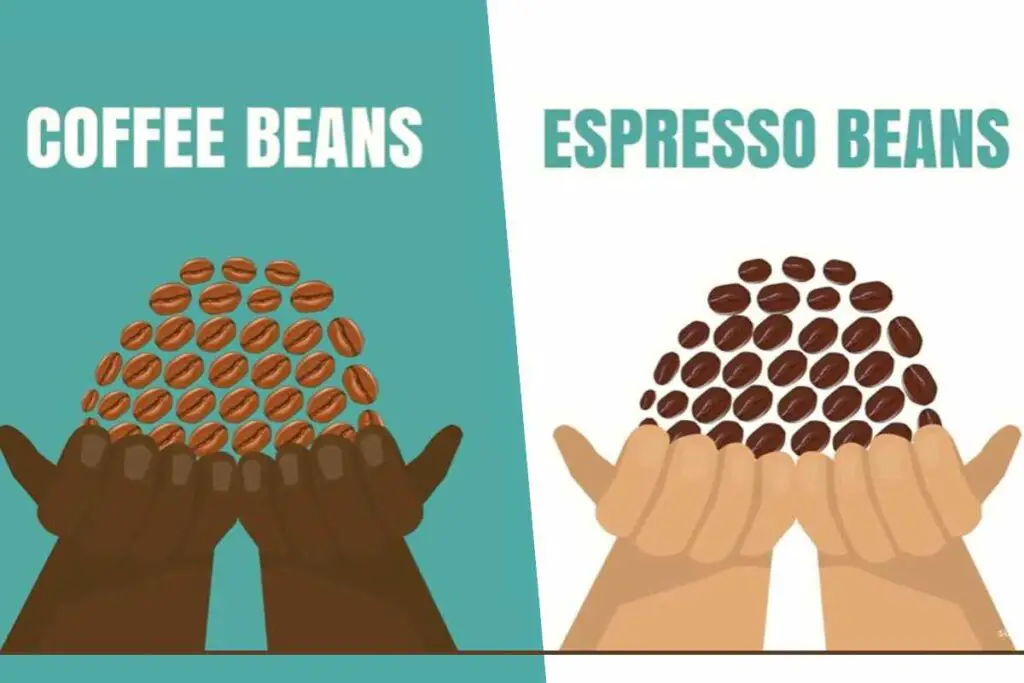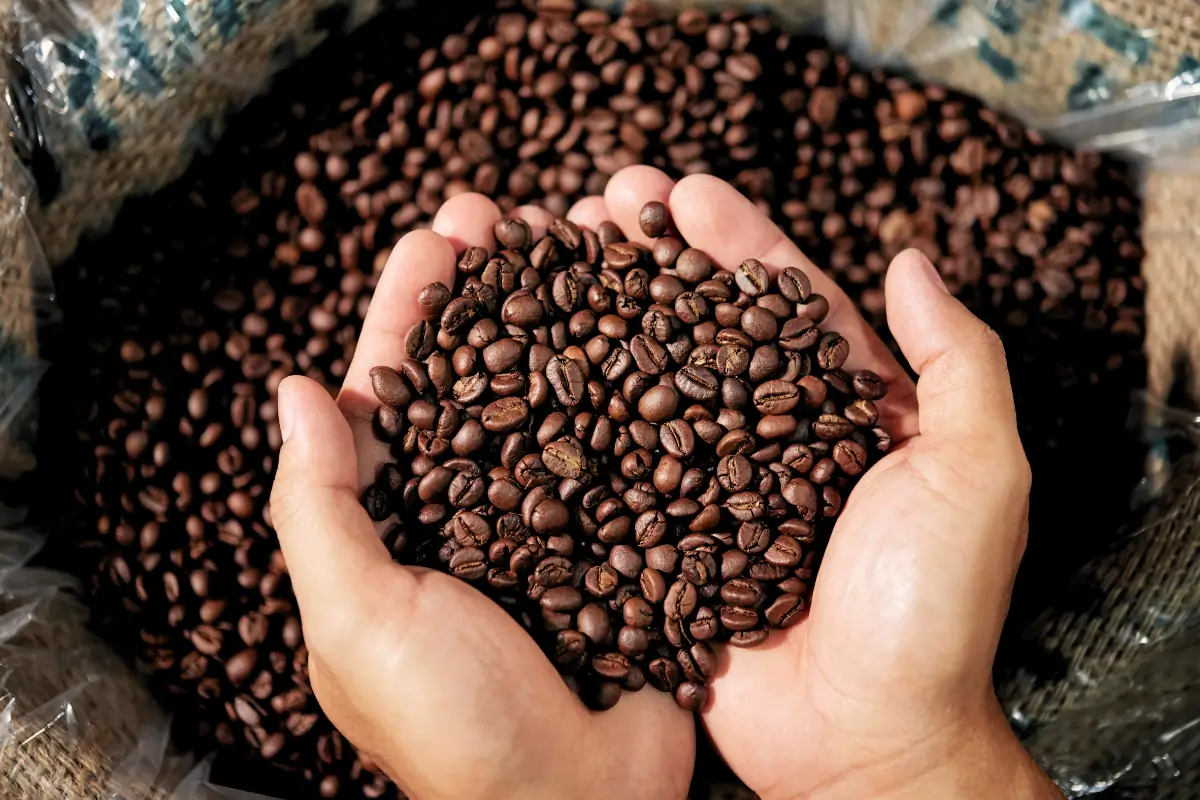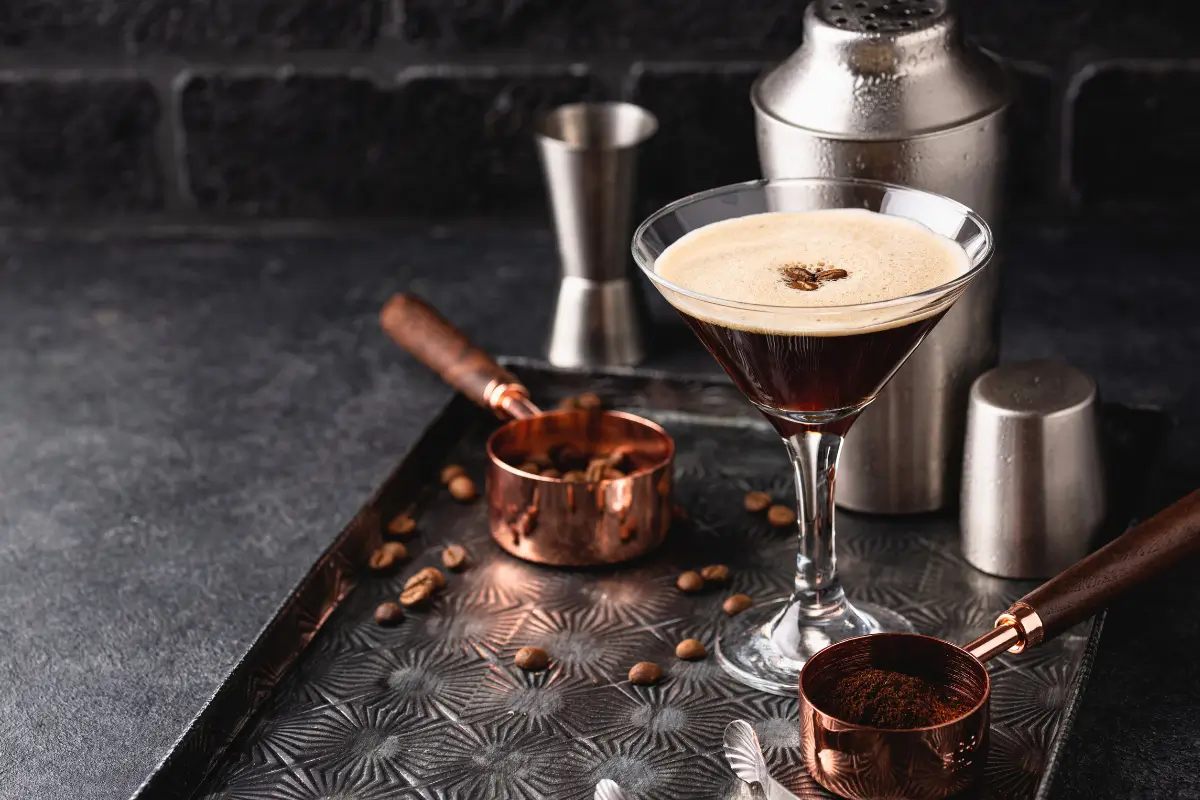Coffee beans and espresso beans refer to the same raw ingredient. The difference lies in the roast and grinds for their intended brewing methods.
Contrary to common belief, the distinction between coffee beans and espresso beans is not in their origin but in preparation. Selecting the right bean for your coffee routine can enhance your daily cup. Coffee enthusiasts often seek beans with the perfect balance of flavor, aroma, and body to suit their taste.
Espresso, a concentrated form of coffee, typically requires a finely ground bean with a dark, oily roast to achieve its signature intense and bold flavor profile. Meanwhile, other brewing methods like drip or French press might opt for a medium to light roast to appreciate the bean’s natural characteristics. Understanding these nuances will enhance your brewing experience, regardless of whether you’re crafting a robust espresso shot or a comforting mug of filter coffee.
Are Coffee Beans the Same As Espresso Beans?
The short answer is yes, coffee beans and espresso beans are essentially the same. The key difference lies in the roasting process and grind size, rather than the bean itself. Discover how these factors influence the taste and strength of your brew.
The Great Bean Debate
The Great Bean Debate rages on in cafes and kitchens around the world. Is there a real difference between coffee beans and espresso beans? This topic stirs quite a discussion among coffee enthusiasts and baristas alike. Many claim the distinction lies in the bean type, while others focus on the roast level. Let’s dive into this fervent discussion and unearth the truths behind these beloved beans.
Coffee Beans Vs. Espresso Beans
At their core, all coffee beans have the potential to become espresso beans. The term ‘espresso’ refers to the brewing process, not the bean itself. Whether used for drip coffee or espresso, the bean starts out the same. The difference emerges through roasting and preparation techniques tailored for the espresso machine’s high pressure. A common practice involves roasting beans longer for espresso to achieve a bolder, more robust flavor.
Common Misconceptions
Identifying misconceptions starts with clarity. One key misunderstanding is that espresso beans come from a special plant. Not true. They come from the same plants as all coffee beans. Another point of confusion is the belief that darker beans pack more caffeine. In reality, lighter roasts retain more caffeine due to lesser roasting time. Let’s bust these myths with facts:
- Espresso beans are just coffee beans optimized for an espresso machine.
- Any coffee bean can be used to make espresso.
- Caffeine levels vary more due to the type of coffee bean and not the roast level.
Bean Basics
Exploring the coffee aisle, questions often brew: Are coffee beans and espresso beans different? At their core, they start the same. Yet, the preparation journey defines each bean’s grand finale. Understanding the nuance unearths the secret to your perfect cup.
Types Of Coffee Beans
Dive into the diverse world of coffee beans:
- Arabica: Known for their sweet, complex flavors and smooth acidity.
- Robusta: Pack a punch with a strong, bold taste and higher caffeine content.
- Liberica: Unique, full-bodied profile with a hint of smoky, woody notes.
- Excelsa: Delight with tart, fruity, and refreshing nuances.
Characteristics Of Quality Beans
What makes a bean shine?
| Aroma | Inviting scent hinting at flavor richness and freshness. |
|---|---|
| Appearance | Even-colored beans without visible imperfections signal care in cultivation. |
| Origin | Single-origin beans offer distinctive tastes tied to their specific terroir. |
| Roast | Dark roast for espresso, highlighting caramelization, and body. |
Freshness is a non-negotiable for quality beans. Choose whole beans over pre-ground, and store them in airtight containers away from light and moisture to maintain their prime state. Traceability matters — premium beans often come with a story of their journey from farm to cup.
The Espresso Difference
Many wonder if espresso beans differ from regular coffee beans. Both start as the same bean. The distinction lies in roasting and grinding. Espresso requires a specific approach. Let’s dive into these differences.
Espresso Roasting Techniques
To create espresso, beans go through a unique roasting process. Roasters aim for a rich, dark color and an oil-coated surface. This gives espresso its signature bold flavor.
Generally, the roasting spectrum for espresso is darker than regular coffee. The roast levels are:
- Full City: A medium-dark roast with a heavy body.
- Vienna: A dark roast, with slight oil sheen, emphasizing chocolate flavors.
- French: Very dark, shiny with oils, and a pronounced roasted taste.
- Italian: The darkest, almost black, very oily, with a bittersweet tang.
Grinding For Espresso
After roasting, the way beans are ground plays a crucial role. For espresso, beans must be ground finely. This is essential for the right extraction during brewing.
Ideal espresso grounds look like table salt, not too coarse, not too powdery. This texture ensures a smooth, flavorful espresso shot. Precise grinding leads to the perfect espresso crema.
| Grind Size | Description | Use |
|---|---|---|
| Fine | Like table salt | Espresso machines |
| Medium-Fine | Slightly coarser | Stovetop espresso makers |
Flavor Profiles Explored
Flavor profiles in coffee can be as complex as a fine wine. Beans labeled for espresso or regular coffee indeed have differences. Let’s dive into the intricate world of coffee flavors.
Taste Comparisons
Espresso beans pack a punch. They offer rich and bold notes. Regular beans tend towards a milder, more balanced cup. Here’s what sets them apart:
- Espresso Beans: These beans usually have a darker roast. They give a concentrated flavor.
- Coffee Beans: Their roast can vary. The flavors range from fruity to sweet.
Impact Of Roasting On Flavor
The roast level is key to a bean’s flavor. Dark roasts offer a stronger taste. Here’s how the process changes the profile:
| Roast Level | Flavor Influence |
|---|---|
| Light | Bright acidity, floral notes |
| Medium | Balanced flavor, some sweetness |
| Dark | Bitter, smoky qualities |
Cultivation And Processing Matters
Understanding coffee beans and espresso beans starts in the fields where they grow. Despite seeming similar, diverse cultivation methods and processing techniques deeply impact the beans’ flavor and suitability for brewing either coffee or espresso. Let’s embark on a journey from the growing regions to the processing methods that differentiate and define these beans.
Growing Regions And Their Influence
The world of coffee blooms across various continents, each imparting unique characteristics to the beans grown within their soils. The climate, altitude, and even the type of soil in these growing regions affect taste profiles. Consider the following:
- African regions such as Ethiopia and Kenya are known for their fruity and floral beans.
- Central and South American countries like Colombia and Brazil grow beans with nutty and chocolatey notes.
- Asian regions, such as Indonesia, produce beans with a bold and earthy flavor.
These differences mean bean selection matters whether aiming for a balanced coffee cup or a rich espresso shot.
From Farm To Cup: Processing Methods
Post-harvest processing transforms the raw coffee cherries into the beans we know and love. The journey from farm to cup involves critical steps:
- Washing removes fruit, revealing the bean.
- Drying can occur in the sun or via machines.
- Milling eliminates layers, exposing the green bean.
- Roasting finally develops the flavor, aroma, and color.
Especially with espresso, roast profile plays a significant role; typically, a darker roast is preferred to achieve that classic, intense espresso taste.
Brewing Methods Unraveled
Many coffee enthusiasts often wonder if coffee beans and espresso beans are different. The truth lies not just in the bean itself, but in the brewing methods. Let’s unravel the mysteries of brewing and see how espresso stands out from other coffee-making techniques.
Espresso Brewing Explained
Espresso brewing is an art form, that requires a fine grind and high pressure to extract rich flavor. Specific espresso machines force hot water through the grounds, creating a concentrated shot. This method is quick and efficient, perfect for a bold and robust cup.
Table for Espresso Brewing Key Points| Aspect | Details |
|---|---|
| Grind Size | Fine |
| Water Temperature | Hot |
| Pressure | High |
| Brew Time | 20-30 seconds |
Alternative Brewing Techniques
While espresso is distinct, other methods showcase coffee’s versatility. Each technique highlights different flavors and experiences. Below are common alternatives:
Unordered List for Brewing Techniques- Drip Brewing: Water filters through grounds, ideal for regular coffee.
- French Press: Steeps grounds, producing a full-bodied taste.
- AeroPress: Uses pressure, similar to espresso, but more forgiving.
- Cold Brew: Steeps in cold water for hours, smooth and less acidic.
For each alternative brewing method, the basic steps are:
- Select suitable coffee beans.
- Grind beans to method-specific coarseness.
- Measure the water and coffee ratio accurately.
- Brew according to method guidelines.
- Serve and enjoy the unique flavors!
The Truth About Labels
Walk into any coffee shop or grocery aisle, and you’ll see beans labeled ‘espresso’ or ‘coffee’. This raises a question: are they different? The packaging suggests so. But is there a real difference between coffee beans meant for espresso versus those meant for drip coffee? Let’s uncover the truth behind these labels and what they really mean for your morning cup.
Marketing Versus Reality
Often, the truth is simpler than the labels imply. Coffee roasters might market beans as ‘espresso’ or ‘coffee’ for different reasons:
- ‘Espresso’ beans are usually roasted longer. They often have a darker, richer flavor.
- ‘Coffee’ beans might be lighter. This suggests a variety of brewing methods.
- The grind is crucial. Espresso requires a fine grind while drip coffee uses a coarser one.
Manufacturers use these labels for guidance. They don’t define the beans’ potential.
Reading Between The Lines Of Packaging
| Label | What it Suggests | The Reality |
|---|---|---|
| Espresso | Only for espresso machines | Great for any brewing method |
| Coffee | General brewing | It can be ground for espresso |
| Dark Roast | Strong and bitter | Not always bitter, but rich |
| Light Roast | Mild flavor | It can be complex and aromatic |
Uncover the truth by experimenting. Try different beans and brewing methods. Labels are starting points, not rules. What matters is the taste you enjoy.
Making The Perfect Cup
Embarking on the journey of brewing an impeccable cup of coffee at home can stir up a mix of excitement and challenge. What sets apart your everyday cup from a barista’s masterpiece often boils down to the understanding that coffee beans and espresso are, in fact, interchangeable.
It’s not the bean that defines your brew; it’s how you treat it. The pursuit of the perfect cup centers on knowing the craft and cherishing every step, from bean selection to the final sip.
Essentials For Home Brewing
Finding the right equipment and selecting the best beans are foundational for home brewing success. Ensure you’re equipped with:
- A quality grinder: It helps in achieving the fine grind needed for espresso.
- A reliable espresso machine or coffee maker: This is essential for consistent pressure and temperature.
- Fresh coffee beans: They ensure your coffee is vibrant and full-bodied.
- Clean, filtered water: It’s crucial, as coffee is 98% water.
Expert Tips For Enhancing Flavor
Mastering your home brew involves more than just the basics. Here’s how to enhance the flavor:
- Use freshly roasted beans: Roast date matters since freshness translates to more flavor.
- Get the grind right: Match the grind size to your brewing method for optimal extraction.
- Water temperature is key: Aim for 195 to 205 degrees Fahrenheit for the best extraction.
- Measure your ratios: Start with a 1:15 coffee-to-water ratio and adjust for taste.
- Tamp correctly: For espresso, even pressure when tamping prevents water channeling.
- Clean equipment after each use: Residue from previous brews can compromise taste.
Achieving a perfect cup is a delightful blend of art and science, one that rewards patience and precision. Enjoy the ritual, and savor the results.
Sustainability And Ethical Considerations
Choosing coffee, be it for your morning espresso or daily brew, holds greater importance than taste alone. The impact on the planet and on the lives of farmers is profound. Understanding the journey from bean to cup highlights the significance of sustainability and ethics in coffee production.
Environmentally Friendly Coffee Practices
Eco-friendly farming methods protect nature and yield superior beans. These practices include:
- Using organic fertilizers instead of chemicals.
- Implementing shade-grown techniques to preserve habitats.
- Recycling coffee byproducts into renewable energy sources.
Farmers who adopt water conservation measures also contribute to healthier ecosystems. These combined actions reduce the carbon footprint associated with coffee cultivation, ensuring a greener future.
Certifications And What They Mean For Consumers
Certifications help discerning consumers identify ethically sourced and eco-consciously produced coffee. Key certifications include:
| Certification | Impact |
|---|---|
| Fair Trade | Guarantees fair payment to coffee growers. |
| Organic | Ensures the absence of synthetic chemicals in production. |
| Rainforest Alliance | Emphasizes conservation and good practices. |
When you choose coffee with these labels, you support ethical labor practices and environmental stewardship. This mindful decision contributes to the well-being of communities and ecosystems alike.
The Verdict
As we reach the end of our flavorful journey, the distinction between coffee beans and espresso beans becomes clearer. Special roasting techniques and grind sizes set them apart, yet they share a common bean origin. This final segment decodes lingering myths and offers clarity on the coffee versus espresso debate.
Myths Debunked
- Espresso beans and coffee beans are distinct. Not quite true. Any coffee bean can become an espresso bean with proper roasting and grinding.
- Espresso requires a special bean. Again, not necessary. The right roast and grind make all the difference, not the bean itself.
- Espresso tastes bitter due to the beans. In reality, bitterness often results from the brewing method, not the bean.
Final Thoughts On Coffee And Espresso Beans
Remember, personal taste reigns supreme. Enjoy coffee? A bean roasted to your liking will be perfect. Fond of espresso? Opt for a darker roast and a fine grind. Experiment with different beans until your taste buds rejoice in that perfect sip. Coffee or espresso, it’s the same bean dancing to different tunes in your cup.
Frequently Asked Questions
Can You Use Regular Coffee Beans For Espresso?
Yes, you can use regular coffee beans for espresso, but specialty espresso beans yield better crema and flavor.
What Is The Difference Between Coffee Beans And Espresso Beans?
The main difference between coffee beans and espresso beans lies in their roast. Espresso beans are typically roasted longer, resulting in a darker, oilier appearance and a stronger, bolder flavor profile ideal for espresso brewing methods.
How Many Coffee Beans Equal An Espresso?
Around 42 to 44 coffee beans are typically used to make a single espresso shot.
Can You Grind Espresso Beans In A Coffee Grinder?
Yes, you can grind espresso beans in a coffee grinder. Ensure it has a fine grind setting suitable for espresso.
Conclusion
Understanding the nuances between coffee and espresso beans is key. While processing and roast levels set them apart, both can improve your brewing experience. Choose the right bean for your palate and preparation style. Brew with confidence, knowing that knowledge enhances the flavor.
Sip, savor, and enjoy your perfect cup!



